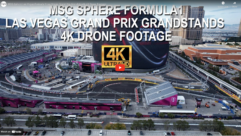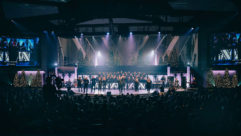In this edition of the SVC Podcast, Contributing Editor Bennett Liles talks with Technical Director Chad Hess of the Florida Hospital Church regarding the new KLANG controlled Shure IEM system the church recently installed as part of an ongoing tech upgrade program. Chad talks about the musicians and how they became accustomed to having a new degree of mobility and 3D monitoring with the new gear.
Links of Interest:
- The Florida Hospital Church in Orlando
- KLANG – With an IEM system that provides 3D monitoring
- Shure PSM 300 Stereo Personal Monitor System
Download Podcast Here:
https://s3.amazonaws.com/nb-svc/public/public/186-1_AVnew_Florida_Hosp_C…
This is the SVC Podcast from Sound & Video Contractor Magazine with Pastor Chad Hess of the Florida Hospital Church. And you can find show notes and product links for this one in Sound & Video Contractor Magazine at svconline.com.
As a church grows so do its technical needs, especially if it has a wide variety of live music. At the Florida Hospital Church they have a little bit of everything and it took a KLANG controlled stage monitoring system to make it work for the musicians. Technical Director Chad Hess is about to tell us how new stage monitoring makes all the difference. Coming up next on the SVC Podcast.
Chad it’s good of you to be with us on the SVC Podcast from the Florida Hospital Church. An interesting name and we’ll get into where that name came from but you’re in the Orlando area, right?
Yes, that’s correct.
Okay. This sounds like a pretty progressive church. That probably means that you have a lot of live music going on.
Yes. It’s all live music; a very blended service. We’re not contemporary, we’re not – and even blended is probably not the right word. We just try and strike the whole gamut. All genres are available. So it’s not like we have to have a hymn and we have to have a praise song. It’s okay, this is the topic. What song of whatever genre, whatever style, is going to fit this? And so we’ve had orchestras, we’ve had quartets, we’ve had strings, steel drums – sometimes in the same service. [Laughs] So it’s a variety of stuff. [Timestamp: 1:24]
Well, that’s great that you don’t just do it the same way every time and I’m sure it keeps the members tuned in to see what’s coming this time.
Yes.
Of course the name of the church got my attention. I don’t think I’ve ever seen the name Hospital Church. And I know the place has an interesting history so what’s the story on how that name came up?
Sure. So for those not familiar with Florida, Florida Hospital is a huge hospital system here. It has like 20-some hospitals, it’s been here over 100 years. And their main campus is right here in Orlando across the street from our hospital. That’s where our origins start is from the doctors and nurses at the hospital wanting a service on the weekend. And so they would get together and they would have a little service just right there on the porch. Over time that grew and it grew and we grew and now we’re a separate institution, but we’re right across the street. We have a very good relationship with them. We actually broadcast live to six of their campuses on Saturday morning. So that’s a little bit of the history there and why the name is there. [Timestamp: 2:46]
Okay. You’ve come a long way then.
We have.
I know there are churches that have started in people’s living rooms and ended up with live TV broadcasts. But Orlando is a huge AV market and you have a lot of companies to choose from for help on this monitoring system.
Yes.
AVnew was the one you got with and Gil Parente is the one there who was in charge. How did you come together on this? Did you already know each other?
Yes. I’ve worked with Gil for as long as I’ve been in this role here which is about eight years or so. Originally he was with a different company and he’s actually a church member here as well, but he’s been my integrator. He’s been my go-to guy. Amazing guy who really knows his stuff, has a heart for the churches and what we need and understands the uniqueness that a church can bring and always works to give us the best solution for our needs. And being that he goes here he actually knows our needs very well. So that just makes it even better. [Timestamp: 3:42]
Well, you’re the technical director so the best guy for him to get with but that title can mean a lot of different things for different churches. The tech director could be the guy who just pushes the piano back into the corner when they’re done with it. I think your job there is quite a bit more challenging so what does the technical director job there involve?
So basically it means I oversee everything technical which would be audio, video, lighting, computers, networking – kind of the whole gamut there. So mostly my job lies with all of the technical equipment for the worship services, the different teams and everything like that, getting it all set up and making sure everything is running smoothly and everything like that. [Timestamp: 4:24]
And this particular project was focused on stage monitoring. You’ve got musicians playing all kinds of live music and with, let’s say, artistic temperaments everybody wants it a different way and their own monitor mix and so most of the performers went with an IEM but then some of them haven’t.
Our singers still use the front wedges, at least for now. We’ve talked about changing that, but that’s been that way for a while. But the band has been on a form of in-ear monitors for a long time. We’ve done several different systems over the years. Before this we were using Allen & Heath’s ME-1 monitoring system which works very well. It’s a nice system. The problem that the band was running into was they wanted some mobility. They wanted to be able to move around. Not that they move around much when they’re playing, but you walk off and your headphones grab you and pull you back kind of thing. And so they had talked about wanting to go wireless and so we were like well, feeing the ME-1’s into wireless can be done, but that’s kind of a lot of work and a lot more cables. Let’s look at some other options. And so talked with Gil and he said you really ought to check out the KLANG system because it’s a really cool system. If you’re wanting to go wireless that would be a great way to do it. So we kind of checked it out and I really liked what I saw and heard. So talked with our minister of music and he was on board with it, he liked it, and so that’s the direction we went. [Timestamp: 5:51]
I would think that probably required a good bit of testing to see how many liked it and probably some more than others. One of the most useful things I think is the 3D monitoring concept where they can have the various sound sources appear to be coming from any direction they like.
Yeah. So one of the things that I like with the KLANG is that it does such a great job of separating it and it makes it very intuitive to do so. So even our ME-1’s, they were fully capable of doing a stereo mix, and I would probably count the number of times our musicians ever actually did it, you know? They’re concerned about just turning it up in volume. They’re not thinking oh, let me pan this over here and that might make it better. They’re just I’m just going to run and I’m just going to do volume. So mostly they would even run in mono essentially. Well, first of all we started out with a template that moved them all around so they’re starting from that position of having a wide mix. But the interface, you have to work hard if you want to make it mono. [Laughs] It really kind of pushes you towards separating out those instruments and vocals to put them in different places so you can hear those and have a wider sonic space to work with. [Timestamp: 7:03]
Yeah the thing that probably took getting used to was the mobility they have now. I would think that for a while you might suddenly stop on stage thinking that was where their ear monitors usually get pulled off by the cable and then remember, you’re free to go wherever you want.
Yeah. They love being wireless. They have been very happy about that.
Now what else went in with this? Was it Shure mics or just RF components for the new IEM?
Well, not Shure mics. The KLANG system is really just the processing. I mean it has the outputs but you need something to feed it into. So we fed those into Shure PSM-300 IEM’s so it’s really the combination of the two forms of the system. [Timestamp: 7:42]
Yeah and I was just thinking that before you have a service there, since you have so many people playing such different types of music you would have to have some fairly intensive rehearsals.
Yes. We have a practice usually on Thursdays or Fridays and they’ll also come in earlier on Saturday morning. Our services are Saturday morning. But they’ll come in several hours beforehand to do more practice and then we talk through the entire service – the whole team does. So even before practice begins on Thursday or Friday I will have everything all set up. I set up the stage – because we strike the stage every week because it’s a very multi-use building. And so I set up based on whatever it is that week that we’re doing. I have that input list and so we set it all up and I get their monitors placed in there and the tablets are ready and charging and so we just leave those on the charger until they’re ready. But basically they can walk in, plug in and they’re good to go. [Timestamp: 8:40]
That sounds like the creativity isn’t just required of the musicians but that it starts with how you decide to physically set up the stage.
Yes. Sometimes that requires a lot of creativity. [Laughs]
Yes I can imagine, or at least knowing exactly what’s going to happen ahead of time for sure.
Yeah.
Of course you’ve got more than just stage monitoring to get right. You’ve got projection, too?
Sure. Yeah, we have one very large screen up front and the confidence monitors in the back for them to see. And so I get that ready as well, make sure all those slides are ready and songs and backgrounds and everything. [Timestamp: 9:16]
And that’s mainly hymn lyrics?
Yeah. Motion backgrounds with lyrics over them.
And you do any IMAG? Is it all robotic cameras or do you have some manned cameras?
For our video system, which we don’t do in-house – I mean that’s – we don’t do live IMAG I should say. We just have – that’s just for our broadcast and our stream. But yes, we have an extensive team, eight cameras, three manned, two remote control and a few static cameras. [Timestamp: 9:44]
A lot of stuff to make sure is working right and if it suddenly doesn’t?
That’s when they come running for me.
Yeah, that’s when they come running for you and hopefully those things and any glitches get fixed before they become part of the show.
Yes.
But Chad, thanks for getting with us for Part 1. You’ve got a lot to get lined up for your services and the KLANG stage monitoring has been a great addition to it. We’ve been talking to Chad Hess, technical director at the Florida Hospital Church in Orlando.
Thank you.
Glad you were here with us today with Chad Hess. You can always find show notes and equipment links for the podcasts on the website of Sound & Video Contractor Magazine at svconline.com. Get back with us again next week hear about how the musicians at the church use Amazon Fire tablets for monitoring control. That’s on the next SVC Podcast.










